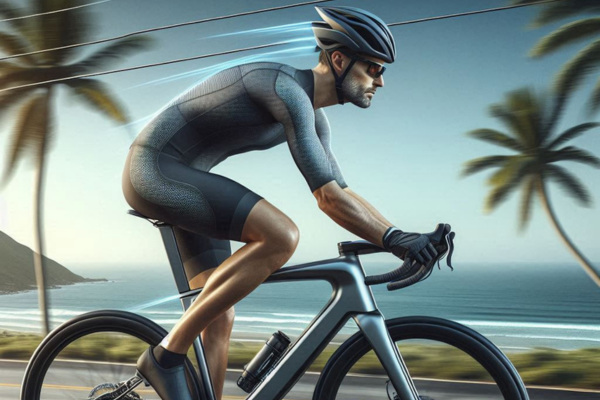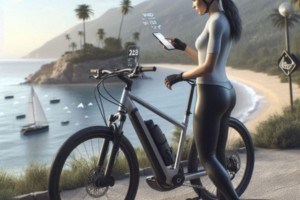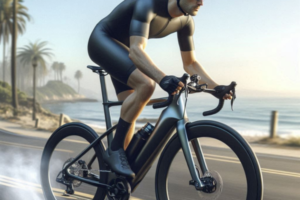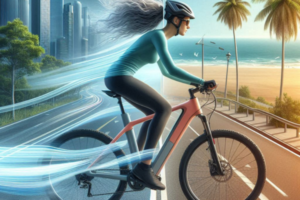👕 Why Aerodynamic Clothing Matters for Coastal E-Bike Riders
When riding an electric bicycle near the coast, wind resistance is more than just a minor inconvenience—it’s a constant force that can influence speed, energy consumption, and overall riding comfort. Unlike cyclists in urban or forested environments, coastal e-bike riders are exposed to wide-open spaces, steady breezes, and sudden gusts that make every piece of apparel matter. That’s where aerodynamic clothing becomes not just a luxury, but a smart and strategic choice.
Aerodynamic apparel is specifically designed to reduce air drag by minimizing loose fabric, optimizing posture alignment, and allowing smooth airflow across the body. On an e-bike, where riders often maintain speeds of 20–28 km/h (12–17 mph), wind resistance can be the main obstacle to forward motion—especially when facing crosswinds or headwinds coming off the ocean. By wearing the right garments, riders can significantly enhance their efficiency and ride longer with less strain on both body and battery.
🌬️ The Unique Challenges of Coastal Riding
Coastal areas present a combination of elements that test clothing performance. The wind is more consistent and unpredictable. Humidity is higher. Temperatures can shift quickly. All of this means that standard cycling clothes, designed for dry climates or mild conditions, may underperform when moisture and air friction combine.
- Wind exposure: Coastal roads are often elevated or open, with few trees or buildings to block gusts.
- Humidity and sweat: High moisture levels make fabric stick to the skin, increasing discomfort and drag.
- Temperature shifts: Cool ocean breezes may turn into hot sun patches along the same route, requiring breathable but insulating layers.
🧠 Why E-Bike Riders Need Aerodynamics Too
There’s a common myth that aerodynamic gear is only for racing cyclists or speed-obsessed riders. But for e-bike users, especially those navigating windy coastal terrain, every watt of power matters. Even with pedal-assist or throttle support, wind resistance increases battery drain and causes unnecessary effort during longer rides.
Moreover, most e-bike commuters ride with additional gear—racks, bags, lights—which already add bulk to the bike. Reducing wind resistance through clothing becomes one of the most practical ways to offset drag and maintain fluid speed. A well-fitted jersey, for example, can help riders save between 10%–20% of wind resistance compared to loose or flapping shirts.
📊 Visual Comparison: Loose vs. Aerodynamic Clothing
| Clothing Type | Wind Resistance | Battery Efficiency Impact | Comfort in Wind |
|---|---|---|---|
| Loose casual jacket | High | Increases usage by 10–15% | Unstable and noisy |
| Standard sportswear | Moderate | Slight drag, minor battery drain | Fair control |
| Aerodynamic cycling jersey | Low | Improves range and motor efficiency | Silent and stable |
🏁 Summary: Clothing Is Part of the Ride
Choosing the right aerodynamic clothing isn’t just about performance—it’s about smart energy use, better posture, and staying comfortable in changing conditions. If you regularly ride in coastal areas, investing in the right fabrics and fits can transform your daily ride from a wind struggle to a smooth glide.
💡 Takeaway: Your body is the first barrier against wind—dress like it matters.
🧵 Materials and Textile Technologies for Windy, Humid Coastal Rides
Choosing the right aerodynamic clothing goes far beyond tight fits—it’s about selecting the proper materials, smart garment construction, and breathable fabrics that can handle the dynamic climate of coastal environments. Coastal e-bike riders regularly face high humidity, wind gusts, salt air, and shifting temperatures, all of which influence how clothing behaves during a ride.
Aerodynamic gear must not only reduce wind resistance—it should also manage moisture, regulate temperature, and resist the elements without sacrificing comfort. The intersection of performance and practicality begins with the fabrics used and how they’re assembled.
🌫️ Breathable and Moisture-Wicking Fabrics
In humid environments, even small amounts of sweat can become a source of discomfort if clothing holds moisture. That trapped moisture increases drag, causes chafing, and can lead to overheating or cold chills when coastal winds pick up. That’s why modern aerodynamic garments use synthetic, quick-dry fabrics designed to pull moisture away from the skin.
- Polyester microfibers: Lightweight and hydrophobic, ideal for wicking sweat quickly without absorbing water.
- Elastane (Spandex): Added for stretch and fit, it provides body contouring without restricting movement.
- Nylon blends: Durable, abrasion-resistant, and often used in panels subject to friction, like inner thighs and shoulders.
🌀 Wind-Blocking Panels and Zoned Construction
High-performance cycling jerseys and jackets often feature multi-panel designs that vary in material density and function. The front chest and shoulders—where wind hits first—are constructed with wind-blocking fabrics, while the back and sides remain more breathable. This dual strategy creates aerodynamic flow while maintaining thermal comfort.
- Windstopper® fabric (or similar): Used in frontal panels to minimize cold airflow penetration.
- Laser-cut hems and sleeves: Prevent fabric flapping and reduce edge turbulence.
- Seamless construction or flatlock stitching: Prevents chafing and maintains aerodynamic surface continuity.
🌡️ Temperature Regulation for Coastal Conditions
Coastal areas can go from foggy and cool to sunny and warm in a single ride. Technical fabrics with temperature-adaptive fibers are ideal for these changing conditions. Some brands now integrate ceramic particles, infrared technology, or 3D mesh that dynamically regulate body heat based on activity and environment.
| Technology | Function | Best Use Scenario |
|---|---|---|
| Infrared yarns | Reflect heat back to the body on cool rides | Early morning coastal commutes |
| Mesh back zones | Ventilate sweat and release heat | Midday or uphill segments |
| Ceramic-infused fabric | UV protection + thermoregulation | Sunny, exposed seaside trails |
🧺 Bonus: Fabric Durability and Maintenance in Salt Air
Salt air is corrosive—not just to your bike, but also to your clothing. Look for garments that are machine washable, quick-drying, and made from fade-resistant synthetics. Avoid natural fibers like cotton or wool for coastal e-bike rides; they absorb moisture, sag under weight, and deteriorate faster in salty environments.
💡 Tip: Your ride is unpredictable—your clothing shouldn’t be. Choose materials that adapt to both wind and water with grace.
👖 Essential Clothing Pieces for Coastal E-Bike Aerodynamics
Dressing for a coastal e-bike ride is more than throwing on tight spandex—it’s about selecting purpose-built pieces that each contribute to better speed, stability, and energy efficiency. In this section, we’ll walk through the most essential clothing items every coastal e-bike rider should consider, explaining how each contributes to aerodynamic performance and ride comfort.
🧥 Jerseys and Jackets: Frontline Against Wind
Your upper body is the first to meet headwinds, which makes aerodynamic tops essential. Whether you’re wearing a lightweight jersey or a windproof shell, the cut, fit, and fabric determine how smoothly air flows over your chest, shoulders, and arms.
- Form-fitting cycling jerseys: Reduce drag and stay in place without bunching, even when leaning forward.
- Windproof cycling jackets: Ideal for cool or breezy mornings; look for vented back panels and packability.
- Elastic waist and sleeve grippers: Keep garments from flapping or shifting, ensuring consistent wind resistance.
👖 Bib Shorts and Tights: Power Meets Comfort
Lower-body apparel must do double duty—maximize comfort during pedaling while maintaining aerodynamic flow. Bib shorts and tights are preferred by experienced riders for their seamless design, support, and fit.
- Bib shorts: Provide core support, eliminate waistband roll, and allow smoother air contact with no gaps.
- Full-length tights with compression panels: Offer extra wind protection on exposed routes and muscle support during long rides.
- Flat seams and contour stitching: Prevent irritation while preserving a clean silhouette in crosswinds.
🧤 Gloves and Sleeves: Small Items, Big Impact
While often overlooked, gloves and arm sleeves enhance both comfort and control—especially in coastal wind. Wind can dry out skin, cause hand fatigue, and introduce micro-vibrations from gusts. The right accessories add stability and insulation.
| Accessory | Aerodynamic Benefit | Rider Comfort Role |
|---|---|---|
| Gloves with grippy palms | Improve steering stability during gusts | Reduce hand fatigue and slippage |
| Arm warmers or sleeves | Streamline exposed skin and reduce chill | Easily removable for mid-ride changes |
| Fingerless gloves with padded inserts | Minimize vibration transfer from handlebars | Increase grip and reduce wrist strain |
🧦 Socks, Base Layers, and Undergarments
It’s easy to forget that even socks and underlayers play a role in ride quality. Base layers regulate core temperature, especially when transitioning between sunny and shaded coastal paths. Aero socks made from compression fabrics can reduce drag from the ankles, a known turbulence zone in bike aerodynamics.
- Compression socks: Improve circulation and streamline leg contours.
- Mesh base layers: Regulate sweat and add a breathable buffer beneath jerseys.
- Seamless underwear: Prevent bunching and friction under tight-fitting bibs.
🎯 Gear Pairing Tips for Windy Conditions
For coastal riders, layering is as much about adaptability as aerodynamics. Try to:
- Pair a windproof vest with breathable sleeves for flexibility in changing weather.
- Stick to neutral or dark colors that don’t show salt or moisture marks as easily.
- Test your setup on windy training days before committing to longer routes or commutes.
💡 Insight: Every garment you wear either works with the wind—or against it. Dress to flow, not to fight.
🧺 Smart Combinations and Outfit Checklist for Windy Coastal Rides
Now that you know the role each garment plays in aerodynamic performance, it’s time to put everything together. Coastal rides demand adaptability—you may start in fog, pass through sun, and end with sea breeze. That’s why assembling your gear should be intentional. This section provides a simple yet comprehensive checklist and layering strategies based on weather, wind strength, and ride length.
✅ Pre-Ride Aerodynamic Clothing Checklist
Before heading out, run through this checklist to ensure your outfit balances performance, comfort, and weather protection:
- ✔️ Fitted jersey with breathable panels and rear pockets
- ✔️ Bib shorts or tights with seamless construction
- ✔️ Windproof vest or jacket, preferably packable
- ✔️ Arm and leg warmers (optional, based on morning temperatures)
- ✔️ Compression socks or aero-specific designs
- ✔️ Breathable gloves with anti-slip grip
- ✔️ Moisture-wicking base layer (mesh or infrared blend)
- ✔️ Clear or tinted glasses to block wind and salt spray
🌦️ Outfit Strategies Based on Coastal Conditions
Every coastal day is different. Use this mini-guide to tailor your clothing choices to what the weather and wind demand:
| Condition | Recommended Clothing Combo | Why It Works |
|---|---|---|
| Cool & windy morning | Jersey + base layer + windproof vest + arm warmers | Blocks chill while keeping core breathable |
| Humid & breezy midday | Lightweight jersey + mesh base + bib shorts | Sweat evaporates efficiently; sleeves remain stable in crosswinds |
| Sunny with tailwinds | UV-resistant jersey + light gloves + aero socks | Maximizes energy return and protects skin from exposure |
| Sudden gust zones (cliffs/bridges) | Tighter fit + glove grip + wind-blocking front panels | Minimizes wobble and supports upper-body control |
📏 Fit and Adjustability Tips
- Test your outfit on short rides first: Check for any fabric flapping, pinching, or overheating.
- Use a mirror or video: Observe how your garments react to wind while riding.
- Avoid mixing loose top with fitted bottom: This causes imbalance in wind deflection and increases drag.
- Choose zippers with ventilation locks: Allows quick airflow control without unzipping fully.
🧠 Comfort ≠ Compromise
Riding smart doesn’t mean riding in discomfort. The ideal aerodynamic outfit supports your body, minimizes distractions, and adapts with your environment. Good gear is gear you forget about once you’re on the road—because it’s doing exactly what it should without getting in your way.
💡 Reminder: Don’t fight the wind. Dress to move with it—and let comfort power your speed.
💬 Frequently Asked Questions (FAQs)
1. Can aerodynamic clothing really make a difference on an e-bike?
Yes, especially in coastal environments where wind resistance plays a larger role. Even at moderate speeds (20–28 km/h), streamlined clothing helps reduce drag, improve comfort, and extend battery life by minimizing unnecessary resistance. The benefits are not only aerodynamic—they’re practical too.
2. Is tight-fitting clothing uncomfortable for long rides?
Not if it’s designed properly. High-quality cycling garments are engineered to hug the body without restricting it. They use stretchable, breathable fabrics and smart seams that reduce friction. Once fitted correctly, they feel like a second skin—supportive, not tight.
3. What’s the most versatile clothing piece for coastal rides?
A windproof vest with breathable back panels. It provides instant protection during breezy mornings or open-road gusts while allowing heat release through your core. It’s easy to layer and pack, making it perfect for unpredictable coastal weather.
4. Can I use regular gym or sportswear instead?
While you can ride in basic athletic wear, it’s not optimized for airflow, wind control, or long-distance comfort. Flapping fabrics, bulky seams, and poor moisture handling make gym clothes less efficient and more fatiguing in coastal conditions.
5. How do I care for technical cycling fabrics in salty environments?
Rinse your garments with fresh water after every coastal ride, even if they don’t appear dirty. Salt can damage elastic fibers and reduce fabric performance. Avoid fabric softeners and tumble dryers. Air dry in the shade and store flat when possible.
💖 Final Thoughts: Ride Like the Wind, Dress for the Elements
Riding an e-bike by the coast is a gift—open roads, fresh air, and a rhythm that connects you to nature. But it’s also a test of preparation and awareness. The wind, humidity, and sun demand not just power in your legs, but intention in your choices.
Aerodynamic clothing is more than just gear—it’s a statement that you value comfort, efficiency, and readiness. It tells the wind: “I’m not here to resist you—I’m here to ride with you.” When your outfit becomes an extension of your movement, every gust becomes manageable, every kilometer more fluid.
Choose garments that move with your body, protect your skin, and adapt to the conditions around you. Because the real secret to coastal riding isn’t in the battery, or the bike—it’s in how you dress to meet the ride.
💡 Inspiration: You don’t need to be a racer to ride like one—just dress like the wind is part of your journey.
🌍 Join the Conversation: What Do You Wear to Beat the Breeze?
We’d love to hear from you. What’s your go-to outfit for coastal rides? Have you discovered a game-changing jacket, base layer, or accessory that helps you feel faster and more confident in the wind?
Share in the comments:
🧤 What’s one cycling garment you’ll never leave home without?
🌬️ How do you layer when wind and sun are both in the forecast?
🚴♀️ What clothing tip would you give to a new e-bike rider near the sea?
Let’s grow together as a community of smart, stylish, and wind-ready riders—one layer at a time. 🌊🚴♀️✨



